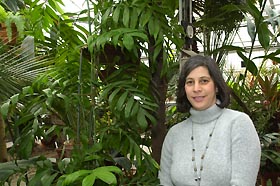|
This is an archived article.
For the latest news, go to the Advance
Homepage
For more archives, go to the Advance Archive/Search Page. |
||
|
Tropical Ecologist Studies
How Rainforests Can Regrow By Elizabeth Omara-Otunnu The destruction of tropical rainforest has for years been a concern of environmentalists. But the forest can regenerate itself, and Robin Chazdon is studying how it happens. Chazdon, a professor of ecology and evolutionary biology, has been working in Costa Rica for nearly 30 years. Since 1997, she has been documenting the regrowth of tropical forest sites near the field station of La Selva.
"These are the forests of the future," she says. Her work has been supported by the National Science Foundation and the Andrew Mellon Foundation. And last month, Chazdon was selected to receive the President's Award from the British Ecological Society, an award given once every two years "for high achievement in the field of ecology." Forests of the Future
In January 1997, Chazdon identified four sites of one hectare (about 2 1/2 acres) each for long-term study. "To understand the whole process, you can't just take a snapshot," she says. "The characteristics now don't tell you much, because they are long-term indicators of conditions that existed previously. During the first year of the study, for example, the El Nino weather pattern caused a drought and led to a very high mortality rate among the trees. Chazdon says the impact of that year's climate variation became evident only over a period of several years. The sites she chose had been pasture for only a short time - five years or so - and had good potential for regeneration. The four sites, abandoned as pasture at different dates, ranging from 30 years ago to 17 years, represent various stages in the natural reforestation process. Already an expert on the mature rain forest, Chazdon became interested in successional - or "pioneer" - plants, those that are the first to establish themselves after a disturbance in the habitat. By taking an annual inventory of the trees in each research site, she has been able to record the sequence by which species return. Long-Term View
"There is a tremendous need to have good measurements of processes in the forest," she says, "and my work is focused on providing some of that detail." One type of data she collects has to do with the availability of light, one of the most important determinants of growth. She looks for links between light availability, the performance of seedlings, and the distribution of trees. The current tree composition of the research sites is a subset of the tree community in nearby forest that has never been cleared, she says. It will take a long time for the regrowing forest to exactly parallel the mature forest, which has some huge and ancient specimens of up to 300 years in age. The composition of seedlings and saplings is more rapidly approaching that of mature forests in the area. Chazdon has studied both the canopy and the understory - the part of the forest below the canopy - to discover how a newly established forest is different from a mature forest. She says the untrained observer might not notice that it is secondary forest, but her research has documented some important distinctions. In a mature forest, the canopy is formed of many different species. The canopy of the secondary forest is less varied, comprising the fastest-growing species. Beneath the canopy, however, are other species that will eventually be incorporated in the canopy but in the meantime have adapted to living in the shade. In the older reforestation sites, some of the first species to arrive are no longer growing, suggesting that some will soon die and make way for others. "The secondary forest has a different dynamic from a mature forest," says Chazdon. "There's a lot of turnover in the canopy. The early trees grow fast and are initially dominant, but they won't remain big players in the future." Accurate Measurements
Another measure, known as basal area, is roughly equivalent to the sum of the cross-sections of the trees in a defined area. Chazdon has found that the basal area of the oldest of the secondary forest sites is similar to that of mature forests. A third important yardstick is the biomass of the trees, or their volume. If the biomass accumulation of a forest is known, the amount of carbon in the forest can be estimated. "There's a lot of interest globally in whether forests are taking up or releasing carbon," says Chazdon. "These forests are growing so quickly, they are very important for removing carbon from the atmosphere." She notes that the Kyoto Protocol, an international environmental treaty, seeks to establish a global limit on greenhouse gas emissions. "Costa Rica is one of the countries poised to sell carbon credits to offset emissions," she says. "There's a lot of interest in our data." Collaborative Effort
She says she would like eventually to hand over all the sites to Costa Rican researchers, but currently the government doesn't have the funds to sustain the research. "I view the project as a collaborative effort," she says. "It's very important to me to contribute to the development of scientific knowledge in Costa Rica." Chazdon's interest in field biology began when she was in high school. She did an independent study in Costa Rica while still an undergraduate at Grinnell College, Iowa, and conducted research at La Selva as a graduate student at Cornell in the early 1980s. "I've been finding a reason to go back ever since," she says. |

